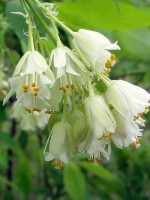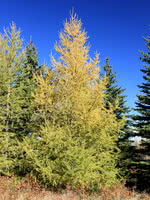Mon-Fri 9am - 5pm Mountain time
Siberian Larch vs American Bladdernut
Staphylea trifolia
Larix sibirica
NOT AVAILABLE THIS SEASON - MIGHT RETURN
American Bladdernut is a fast-growing, ornamental shrub native to eastern North America. It can be grown as a large shrub or trained as a small tree. The small, drooping, white flowers are bell-shaped and grow in clusters. They appear in mid to late spring, attracting various pollinators. Well suited as an understory plant as it prefers shady and partial sun location with moist soils.
The blossoms mature into papery seed capsules and have been described as miniature Japanese lanterns. They are commonly used in dried flower arrangements. The seeds found within the pods are edible, and have a taste similar to pistachios. They can be eaten raw, used in baking or made into a sweet cooking oil.
Care should be taken when planting American Bladdernut, as it can spread quickly. It is prone to suckering and will self-seed. Plant the right tree in the right place.
Siberian Larch is a large, cold hardy conifer. Like the Tamarack, its needles turn golden yellow and drop in the fall, and it is able to handle saturated soils.
If you are looking for a long-lived tree for your large property or shelterbelt with quite wet soil, this is the tree for you.
This variety is often used on the south side of a shelterbelt to let sunlight in during the winter and to provide protection or shading during the summer.

